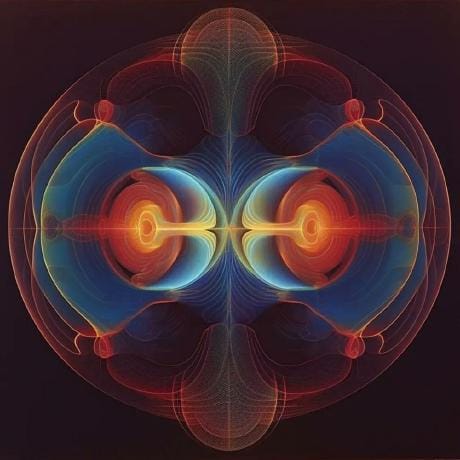This document explains the mathematical concepts implemented in the Higher Dimensional Geometry Visualizer.
In 4D space, we work with coordinates (x, y, z, w) where w is the fourth spatial dimension. This is different from spacetime where time is often considered the fourth dimension.
-
Tesseract (4D Cube)
- 16 vertices
- 32 edges
- 24 square faces
- 8 cubic cells
- Construction: Two 3D cubes connected through the 4th dimension
-
16-Cell (4D Cross-polytope)
- 8 vertices (±1 on each axis)
- 24 edges
- 32 triangular faces
- 16 tetrahedral cells
- Dual of the tesseract
-
600-Cell
- 120 vertices
- 720 edges
- 1200 triangular faces
- 600 tetrahedral cells
- Most complex regular 4D polytope
5D space uses coordinates (x, y, z, w, v) with five spatial dimensions.
-
Penteract (5D Cube)
- 32 vertices
- 80 edges
- 80 square faces
- 40 cubic cells
- 10 tesseract hypercells
-
5-Simplex (5D Tetrahedron)
- 6 vertices
- 15 edges
- 20 triangular faces
- 15 tetrahedral cells
- 6 4-simplex hypercells
Since we can only visualize in 3D, we need projection methods to display higher-dimensional objects.
For 4D to 3D projection:
factor = distance / (distance - w)
x' = x * factor
y' = y * factor
z' = z * factor
For 5D to 3D (double projection):
- Project 5D to 4D using the v-coordinate
- Project the resulting 4D to 3D using the w-coordinate
Simply drop one or more dimensions:
- 4D to 3D: (x, y, z, w) → (x, y, z)
- 5D to 3D: (x, y, z, w, v) → (x, y, z)
Projects from a hypersphere to a hyperplane, useful for avoiding singularities:
factor = radius / (radius - w)
x' = x * factor
y' = y * factor
z' = z * factor
In 4D, rotations occur in planes rather than around axes. There are 6 possible rotation planes:
- XY plane: rotates x and y coordinates
- XZ plane: rotates x and z coordinates
- XW plane: rotates x and w coordinates
- YZ plane: rotates y and z coordinates
- YW plane: rotates y and w coordinates
- ZW plane: rotates z and w coordinates
Rotation matrix for plane XY with angle θ:
[cos θ -sin θ 0 0 ]
[sin θ cos θ 0 0 ]
[ 0 0 1 0 ]
[ 0 0 0 1 ]
5D has 10 possible rotation planes: XY, XZ, XW, XV, YZ, YW, YV, ZW, ZV, WV
Applied uniformly across all dimensions:
- Scaling: multiply all coordinates by scale factor
- Translation: add translation vector to position vector
A cross-section is created by intersecting a higher-dimensional object with a hyperplane.
Intersecting a 4D object with a 3D hyperplane (e.g., w = constant) produces a 3D shape that reveals the "interior" structure.
Algorithm:
- For each edge in the 4D shape
- Check if the edge crosses the hyperplane
- Calculate intersection point using linear interpolation
- Connect intersection points to form the cross-section
For an edge from point A to point B, intersection with hyperplane w = c:
t = (c - A.w) / (B.w - A.w)
intersection = A + t * (B - A)
For regular polytopes, the Euler characteristic χ relates vertices (V), edges (E), faces (F), etc.:
4D: χ = V - E + F - C = 0 (where C = cells) 5D: χ = V - E + F - C + H = 0 (where H = hypercells)
- Tesseract: BC₄ symmetry (384 symmetries)
- 16-cell: BC₄ symmetry (384 symmetries)
- 600-cell: H₄ symmetry (14,400 symmetries)
- 120-cell: H₄ symmetry (14,400 symmetries)
Higher-dimensional projections can create overlapping elements that are difficult to interpret. Solutions:
- Use transparency and opacity
- Color coding by dimension
- Animation to show different perspectives
Parts of the object may be hidden behind other parts. Solutions:
- Wireframe rendering
- Cross-sections to see interior
- Interactive rotation
Higher-dimensional objects can have vastly different scales in different projections. Solutions:
- Adaptive scaling
- Multiple projection methods
- User-controlled zoom and perspective
- Vertex transformations: O(n) where n = number of vertices
- Projection calculations: O(n)
- Cross-section calculations: O(e) where e = number of edges
- Rendering: O(v + e + f) for vertices, edges, and faces
- Level of Detail (LOD): Reduce complexity for distant objects
- Frustum Culling: Don't render objects outside view
- Occlusion Culling: Don't render hidden objects
- Instancing: Reuse geometry for repeated elements
- Web Workers: Offload calculations to background threads
- Quantum mechanics (wave functions in higher dimensions)
- String theory (extra spatial dimensions)
- Data visualization (high-dimensional datasets)
- Understanding geometric concepts
- Visualizing abstract mathematical objects
- Developing spatial reasoning skills
- Advanced animation techniques
- Procedural generation
- Novel rendering methods
- "The Fourth Dimension" by Charles Howard Hinton
- "Geometry of Four Dimensions" by Henry Parker Manning
- "Regular Polytopes" by H.S.M. Coxeter
- "Visualizing Quaternions" by Andrew J. Hanson
- "Higher-Dimensional Geometry" by Branko Grünbaum
This visualizer implements:
- Real-time 4D and 5D transformations
- Multiple projection methods
- Interactive cross-section analysis
- Performance-optimized rendering
- Educational interface with mathematical explanations
The mathematical calculations are performed using custom libraries that handle:
- Vector and matrix operations in 4D and 5D
- Geometric primitive generation
- Projection algorithms
- Intersection calculations for cross-sections
